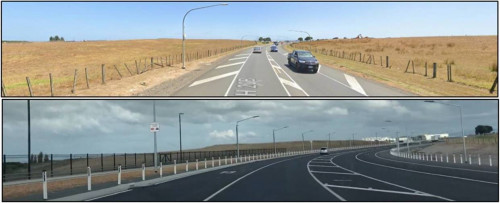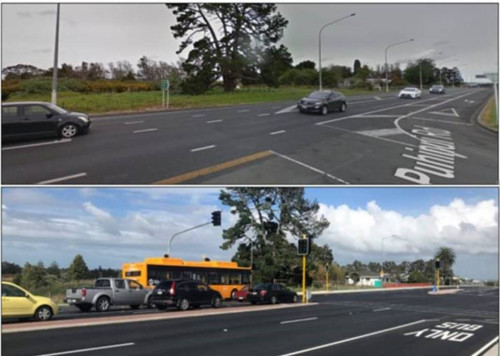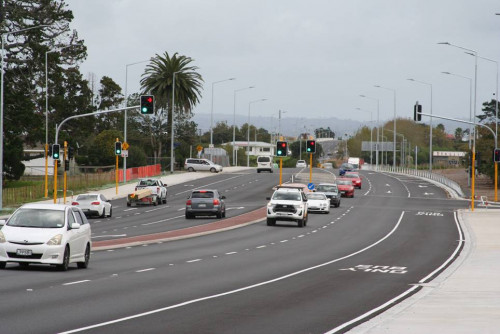The completion of improvements to State Highway 20B marks a significant milestone to support clean, green transport networks in southwest Auckland and will improve public transport options for getting to and from Auckland Airport.

Ribbon cutting ceremony for SH20B Early Improvements project, from left: Fulton Hogan Chief Executive Graeme Johnson, Auckland Mayor Phil Goff, Transport Minister Michael Wood, Auckland International Airport Chief Executive Adrian Littlewood, Te Ākitai Waiohua Kaitiaki David Wilson.
The State Highway 20B Early Improvements project has added new lanes in each direction for buses and T3 vehicles to share. A shared path for people on foot and bikes will provide locals and commuters with more transport options for getting to the airport, work, schools and shops.
“This project is a great step along the way to reducing carbon emissions as it gives people cleaner, more environmentally friendly and efficient transport options,” says Waka Kotahi National Manager Infrastructure Delivery Andrew Thackwray.
The new bus lanes between Pūkaki Creek Bridge and the SH20 interchange will support electric AirportLink buses providing a frequent service between the airport, Puhinui Station Interchange and Manukau.
Auckland Mayor Phil Goff welcomed the completion of the work.
“The State Highway 20B Early Improvements project will make travel to and from the airport and its employment precinct faster, more reliable and more convenient, as well as encouraging more people to use public transport,” he says.”
“Vehicles carrying three or more people will also be able to use the bus/T3 lanes, encouraging people to car share. With transport emissions making up more than 40 per cent of Auckland’s emissions profile, this will contribute to achieving Auckland’s climate change goals, as well as helping to improve traffic flow on our roads.”
With southern Auckland identified as a rapidly expanding area, these changes will also help provide for future community and business growth, by making it more efficient for people and freight to move around.
“I want to acknowledge the hard work of our Waka Kotahi team working together with our contractor Fulton Hogan to get this project completed on time, despite Covid-19 disruptions and the challenges presented by working in a live traffic environment. The crew made the most of full night-time closures, working safely and efficiently to minimise disruption and finish in a timely fashion. We also appreciate the patience of the public during this time,” says Andrew Thackwray.
“As a result, the improvements will now help to provide safer and more reliable journey experiences as we prepare for an increase in traffic to Auckland Airport when Trans-Tasman travel ramps up.”
Auckland Airport General Manager Infrastructure, André Lovatt, said the improvements to SH20B are part of a programme to bring greater connectivity for travellers and provide an important link for airport workers.
“At Auckland Airport, we’ve long supported the development of high-occupancy vehicle lanes and increased public transport options on this route. These developments strengthen the connections for workers and travellers going between the airport and the community,” says Mr Lovatt.
“By investing in projects like this, the airport’s wider transport network is better able to play its part in the long-term success of our city and country.”
The project greatly improves safety along the corridor with improvements including barrier protections, improved lighting and a reduced speed limit.
“These enhancements fit with the Government’s Road to Zero strategy which aims to reduce deaths and serious injuries on our roads by 40 percent over the next 10 years, by designing a safe transport network which allows for drivers to make mistakes, ” says Waka Kotahi National Manager Infrastructure Delivery Andrew Thackwray.
The SH20B Early Improvements project is part of a wider programme of works called the Southwest Gateway programme to improve travel choice around southwest Auckland and the airport. The programme is being carried out by Waka Kotahi, Auckland Transport and Auckland Airport in partnership with Te Ākitai Waiohua.
Crews will remain working on site overnight for a few more weeks to install storm water drainage and lay new asphalt.
The Southwest Gateway programme

SH20B looking west towards Auckland Airport, before (Feb 2020) and after (April 2021); road widening, new T3/Bus lanes, roadside barriers, shared cycling and walking path and improved lighting.

Showing intersection on SH20B before (Feb 2020) and after (April 2021) including new signalised traffic lights, bus/T3 lanes.

Intersection of SH20B and Manukau Memorial Gardens, looking from east to west highlighting new T3/Bus lanes and new signalised traffic lights.
Plan ahead for a safe, enjoyable journey. Keep up to date with: